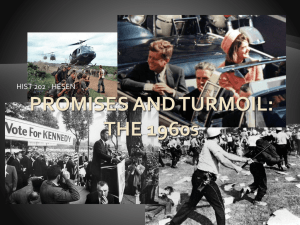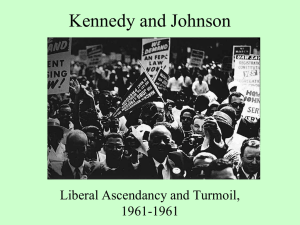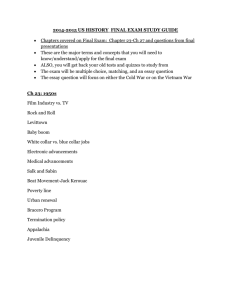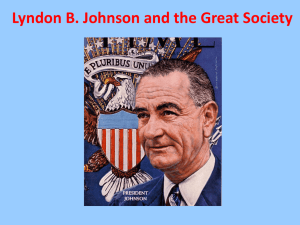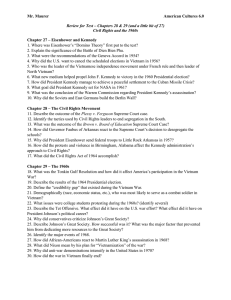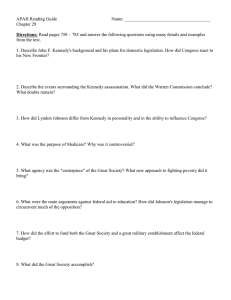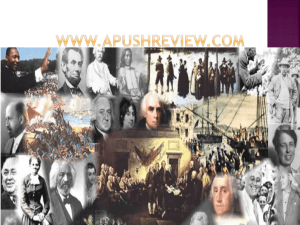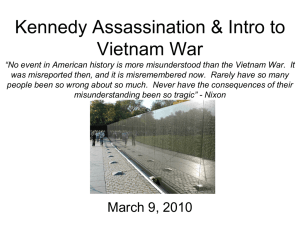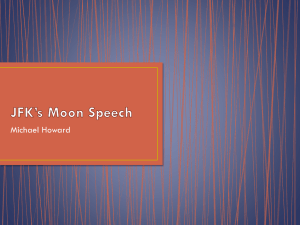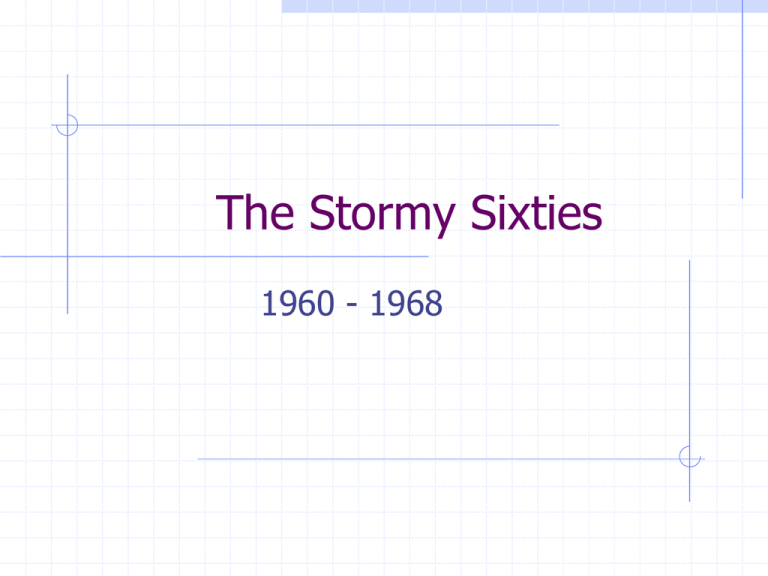
The Stormy Sixties
1960 - 1968
John F. Kennedy
Youngest cabinet
Robert “Bobby” Kennedy as Attorney General
Reform the FBI: focus more on organized crime & civil
rights violations instead of all on internal security
Sec of Defense – Robert S. McNamara
“New Frontier” – domestic policy
Peace Corps – bring American skills to
underdeveloped countries
The New Frontier at Home
Proposed medical assistance for the aged and
increased federal aid to education
Remained stalled in Congress
Helped negotiate a noninflationary wage
agreement with the steel industry in 1962
Steel industries increased prices then backed
down
General tax-cut to stimulate the economy
Project to land on the moon
1969 – Edwin “Buzz” Aldrin & Neil Armstrong
1969 moon landing
1969 moon landing
On July 20, 1969, American astronauts
Neil A. Armstrong (shown above) and
Edwin E. (Buzz) Aldrin, Jr., plant an
American flag on the moon, thus
fulfilling President John F. Kennedy's
pledge to land a man on the moon by the
end of the 1960s. (NASA)
Copyright © Houghton Mifflin Company. All rights reserved.
Rumblings in Europe
JFK met Khrushchev in June 1961 in Vienna
Soviets threatened to make a treaty with East
Germany & cut off Western access to Berlin
Soviets backed down but began to construct the
Berlin Wall in Aug 1961
Expansion of European-American trade
Trade Expansion Act in 1962 – cut tariffs by 50%
Promote trade with Common Market countries (Kennedy
Round)
Charles de Gaulle of France started
developing his own atomic force
Foreign Flare-ups
African Congo
Received its independence from Belgium in 1960 then exploded
into violence
UN sent in a peace keeping force financed mainly by the US
Laos
Freed from France in 1954, then civil war began
JFK imposed a shaky peace in 1962
“Flexible Response” – McNamara
Developing an array of military options that could be matched to
the crisis
Replaced Dulles’s massive retaliation policy
Developed the Special Forces (Green Berets)
An elite antiguerrilla outfit trained to survive under harsh conditions
Vietnam
Diem gov’t in Saigon had ruled shakily since
the split of Vietnam in 1954
Anti-Diem group headed by Viet Cong
threatened to topple the pro-American gov’t
1961 – JFK ordered an increase in the
number of “military advisors” in South
Vietnam
Encouraged a successful coup against Diem in Nov
1963
Bong Son, Vietnam, 1966
Bong Son, Vietnam, 1966
A Vietnamese mother and her children,
framed by the legs of a soldier in the
U.S. First Cavalry Division. (Wide
World/AP Photo/Henri Huet)
Copyright © Houghton Mifflin Company. All rights reserved.
Cuban Confrontations
1961 – Alliance of Progress
Extended the hand of friendship with Latin
America // Marshall Plan for Latin America
CIA planned to overthrow Fidel Castro
Invade Cuba with anticommunist exiles & they
would trigger an uprising
April 17, 1961 – Exiles landed at the Bay of Pigs
No match for Castro’s air force
Exiles were forced to surrender
Castro was pushed further towards the USSR
Cuban Missile Crisis
October 1962 – U-2 spy plane discovered that the Soviets
were installing nuclear tipped missiles in Cuba
October 22 – JFK ordered a naval “quarantine” of Cuba &
demanded immediate removal of the weapons
Warned USSR that an attack on the US would lead to an attack
on the USSR
Soviet ships approached the patrol line
October 28 – Khrushchev agreed to a partially
compromise & agreed to remove the missiles
US agreed not to invade Cuba & would remove US missiles in
Turkey aimed at the USSR
Catch up with the Russians
US expanded the military
JFK pushed for a nuclear test-ban treaty with the
USSR
Pact prohibiting trial nuclear explosions was signed in 1963
Aug 1963 – Moscow-Washington “hot line” was
installed
JFK tried to lay the foundations for a realistic policy
of peaceful coexistence
Origins of the “dètente” policy (French for relaxation)
Struggle for Civil Rights
JFK had pledged to eliminate racial discrimination in
housing during his campaign
Took him 2 years
He did not want to isolate Southerners in Congress
Freedom Riders – 1960
Goal was to end segregation in facilities serving interstate bus
passengers
May 1961 - white mob torched a bus in Alabama
Attorney General Bobby Kennedy’s personal representative was
beaten unconscious
Federal marshals were sent to protect the Freedom Riders
Dogs turned on Birmingham demonstrators
Dogs turned on Birmingham demonstrators
The ferocious attempts by local authorities in Birmingham, Alabama, led by Eugene "Bull"
Connor, to repel nonviolent black protesters using fire hoses (capable of 100 pounds of water
pressure per square inch), electrically charged cattle prods, and police dogs were shown nightly on
television. Tactics such as these made white supremacy an object of revulsion throughout most of
the country and forced the Kennedy administration to intervene to end the crisis. (Wide World)
Copyright © Houghton Mifflin Company. All rights reserved.
JFK & Civil Rights
JFK became weary of King’s associates
(Afraid that they had communist associations)
Robert Kennedy ordered the FBI director, J. Edgar
Hoover, to wiretap King’s phone in 1963
Voter Education Project launched to register
black voters in the South
Oct 1962 - James Meredith registered at the
University of Miss with the help of 400 federal
marshals & 3000 troops
TV viewers watched peaceful marchers attacked
June 11, 1960 – On TV, JFK called for civil rights
legislation
More Civil Rights
March on Washington
King & 200,000 demonstrators sowed support for
JFK’s civil rights legislation
“I Have a Dream Speech”
June 11, 1963 – Medgar Evers was killed
Sept 1963 – explosion at a Baptist church in
Birmingham killed 4 young girls
JFK died before passing his civil rights bill
The Killing of Kennedy
Nov 22, 1963 – JFK was assassinated in Dallas
Lee Harvey Oswald was arrested then shot
Jack Ruby assassinated Oswald
Chief Justice Warren conducted an investigation
The Warren Commission
Lyndon B. Johnson became president
Followed most of JFK’s policies
JFK known more for his ideals than his
accomplishments
JFK assassination
JFK assassination
As Jacqueline Kennedy reacts to her husband being fatally shot in the head, their
open-air limousine races to nearby Parkland Hospital. The president died less than an
hour later. CBS television news anchor Walter Cronkite cried as he told the nation
the news. (National Archives)
Copyright © Houghton Mifflin Company. All rights reserved.
LBJ as President
Legislative wheeler & dealer
More successful in Congress
Honor JFK by supporting his Civil Rights Bill
Civil Rights Act of 1964
Banned racial discrimination in most private facilities open to
the public – theaters, hospitals, restaurants
Strengthened federal gov’t to end segregation in schools &
other public places
Created Equal Employment Opportunity Commission (EEOC)
Title VII passed with the sexual clause
Issued an executive order requiring affirmative
action (federal jobs)
President Johnson signing the Civil Rights Act, 1964
President Johnson signing the Civil Rights Act, 1964
Surrounded by an illustrious group of civil rights leaders and members of Congress,
President Lyndon B. Johnson signs the Civil Rights Act of 1964. Standing behind the
president is Reverend Martin Luther King, Jr. (Corbis-Bettmann)
Copyright © Houghton Mifflin Company. All rights reserved.
LBJ treatment
LBJ treatment
Not content unless he could wholly
dominate friend as well as foe, Lyndon
Johnson used his body as well as his
voice to bend others to his will and gain
his objectives. (Lyndon B. Johnson
Presidential Library)
Copyright © Houghton Mifflin Company. All rights reserved.
LBJ’s Domestic Policies
LBJ was successful in passing JFK’s tax bill with
added proposals for his “War on Poverty”
Concerned about Appalachia
“Great Society”
Set of New Dealish economic & welfare measures
aimed at transforming American life
Michael Harrington’s The Other America (1962)
20% of population in poverty
40% of blacks in poverty
Johnson v. Goldwater
Election of 1964
Democrat – Johnson
Republican – Barry Goldwater
Attacked federal income tax, Social Security, TVA,
civil rights, nuclear test-ban treaty, & the “Great
Society”
Johnson won easily
Tonkin Gulf Episode
Aug 1964 – US Navy ships had been helping
South Vietnam in raids along the coast of
North Vietnam
2 US ships were allegedly fired upon on Aug 2 & 4
(Later reports believe NV fired in self defense on 2nd
& nothing happened on the 4th)
Johnson deemed this an unprovoked attack
Ordered an air raid against North Vietnamese bases
Convinced Congress to pass the Tonkin Gulf
Resolution
Gave the president a blank check in dealing with Southeast
Asia
The Great Society Congress
War on Poverty
Doubled the appropriations of the Office of Economic
Opportunity
Granted money to Appalachia
2 new cabinet offices
Department of Transportation
Department of Housing and Urban Development (HUD)
First black cabinet member – Robert C. Weaver
Creation of the National Endowment for the Arts &
Humanities
LBJ’s Great Society
Big Four
Aid to education
Project Head Start
Medical care for the elderly & indigent
Medicare – elderly - 1965
Medicaid – poor 1965
Immigration reform
Immigration & Nationality Act of 1965 – abolished the
quota system
“family unification” provisions
New voting rights bill
Black Revolution Explodes
Struggle
24th Amendment (1964) abolished poll tax in federal
elections
Freedom Summer of 1964
3 were killed in Mississippi // FBI arrested 21
1965 – King resumed voter registration in Selma,
Alabama
Attacked with tear gas & whips
Voting Rights Act of 1965
Outlawed literacy tests & sent federal voter
registrars into several southern states
Black Power
Watts Riot in Los Angeles (1965)
Blacks were enraged by police brutality burned &
looted their own neighborhoods
Began militant confrontation
Malcolm X – Nation of Islam
Black separatism
Stokely Carmichael – leader of SNCC
Black Power
Emphasized African American distinctiveness
April 4, 1968 – King was assassinated by
James Earl Ray in Memphis
Combating Communism
Dominicans rose in revolt in April 1965
American troops were sent to restore order
Johnson was widely condemned
Vietnam continues
Viet Cong attacked American air base at Pleiku,
South Vietnam in Feb 1965
Johnson ordered retaliatory bombings & land
attacks
March 1965 – Operation Rolling Thunder
Regular full-scale bombing attacks against North Vietnam
Vietnam
Johnson planned “step-by-step” escalation of
American forces
This would drive the enemy to defeat
Not successful
South Vietnamese were becoming spectators
in their war
Domino theory
Began in the 1950s by Eisenhower
Idea that if one nation in Asia fell to communism
then others would follow
Vietnam Vexations
Several nations expelled Peace Corps
volunteers because of American involvement in
Vietnam
de Gaulle ordered NATO off French soil in 1966
Soviet Union expanded their influence in the
Mediterranean area, especially in Egypt
Six-Day War June 1967 – Israel defeated Egyptians
Israel gained new territories including Golan
Heights, the Gaza Strip, and the West Bank of the
Jordan River, including Jerusalem
Anti-War Demonstrations
Began on a small scale in 1965 on college
campuses
Gradually expanded into much larger protest
Draft dodgers went to Canada & others burned
this draft cards
Marchers filled the streets of New York, San
Francisco, other major cities
Opposition in Congress
Senator William Fulbright head of the Senate
Committee on Foreign Relations
Televised hearings in 1966 & 1967
“Credibility gap” between government & the people
"Girls say yes to boys who say no," 1968
"Girls say yes to boys who say no,"
1968
Those opposing the war in Vietnam not
only demonstrated against the war but
also encouraged young men to resist the
draft. Here, singer and activist Joan Baez
(left) and her sisters suggest one
"benefit" those who say "no" to the draft
might expect. (National Museum of
American History, Smithsonian
Institution, Washington, D.C.)
Copyright © Houghton Mifflin Company. All rights reserved.
Johnson Responds
Announced “bombing halts” in 1966 & 1967
Used by both sides to funnel more troops into South
Vietnam
1967 – LBJ ordered the CIA to spy on antiwar
activists
FBI was instructed to sabotage peace groups
Tet Offensive
Jan 1968
Viet Cong attacked 27 key South Vietnamese cities
including Saigon, simultaneously
Military defeat for Viet Cong but it was a political
victory
American military leaders responded with a request
for 200,000 more troops
Request rejected
Campaign of 1968
Democrats
Eugene McCarthy – antiwar college students as
campaign workers
Robert F. Kennedy
Lyndon B. Johnson
Announced on March 31, 1968 that he would apply the
brakes to Vietnam
Freeze American troop levels & shift more responsibility to
South Vietnam
Also declared that he would not seek reelection
Violence at Democratic Convention
Violence at Democratic Convention
Photographs and televised pictures of the Chicago police beating and gassing antiwar
protesters and innocent bystanders at the Democratic convention in 1968 linked
Democrats in the public mind with violence and mayhem. The scenes made
Republican Richard Nixon a reassuring presence to those he would term "the silent
majority." ((c) Bettmann/Corbis)
Copyright © Houghton Mifflin Company. All rights reserved.
Presidential Election of 1968
Hubert H. Humphrey – replaced Johnson
June 5, 1968 – Robert Kennedy was assassinated
Because of his pro-Israel views
Democratic Convention – Aug 1968
Riot broke out
Republicans – Richard Nixon
Spiro Agnew – running mate
American Independent Party – George C. Wallace
Nixon won - Minority president who owed his election
to divisions over the war & protests
Lyndon Johnson
Accomplished a lot for civil rights
Compassion for the poor, blacks, & the ill
educated
Crucified by Vietnam
Cultural Upheaval in the 1960s
Negative attitude against authority
Change in traditional morals & values
Loss of patriotism
Free Speech Movement – Berkeley in 1964
Mind-Bending drugs such as LSD very popular
Hippies
Sexual revolution – birth control
Dr. Alfred Kinsey – wrote books on adultery &
premarital sex
Flower Children & Flower Power
Hippies in their garden of grass
Hippies in their garden of grass
"Grass opened up a new space for middle class white kids," wrote chronicler of the
drug culture Jay Stevens, "an inner space as well as outer space. It became a ritual-sitting around with your friends, passing a joint from person to person, listening to
music, eating, talking, joking, maybe making out--all the senses heightened." (John
and Leni Sinclair Collection, Bentley Historical Library,University of Michigan)
Copyright © Houghton Mifflin Company. All rights reserved.
3 Ps of the 1960s
Population – youthful bulge
Protest against racism & the Vietnam War
Prosperity

